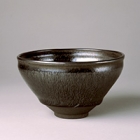Japanese Gallery (Honkan) Room T2
September 30, 2014 (Tue) - November 24, 2014 (Mon)
From long ago, the Japanese had been attracted to and pursued the collection of artworks and other cultural objects from China. These were collectively known as karamono. They were displayed at poetry competitions, tea ceremonies, and other gatherings held by the shogun and other military elite beginning in the Kamakura (1192-1333) and Muromachi (1392-1573) periods. The demand for karamono and the increasing popularity of tea ceremony led to the production of similar Chinese-style objects in Japan. Kilns that began producing objects modeled after karamono became highly regarded and preexisting Japanese applied arts, by way of contrast to karamono, were also reevaluated in a positive light.
The Japanese also ordered ceramics directly from Chinese kilns. These included high-quality blue and white porcelain (kosometsuke and shonzui) as well as roughly-made Swatow ware (gosude). Made to their customers' specifications and unlike anything the Chinese had ever used before, these "uniquely Japanese" ceramics from China may be classified as another kind of karamono.
This exhibition is divided into three sections. In the first, karamono will be displayed according to the Kundaikan sou choki - a text over 500 years old which discusses the display of such objects in Japanese-style rooms. In the second section, Japanese objects modeled after karamono (such as tea bowls and tea caddies) as well as those made with techniques originally used in karamono (such as Kamakura-bori lacquerware) will be displayed. The last section will focus on Japanese taste for Chinese art as reflected in imported Chinese and Japanese-made porcelain, changes in this taste, and its influence on Imari and Kyoto ceramic wares.

